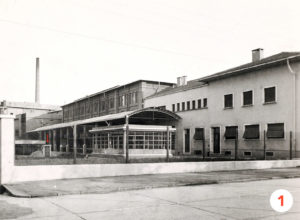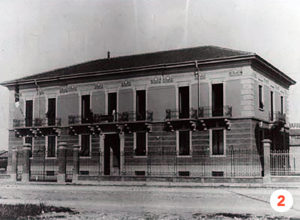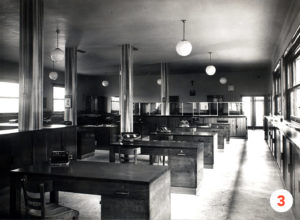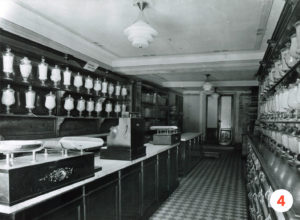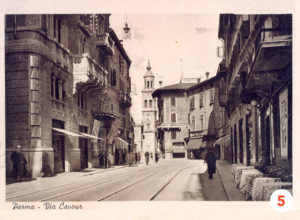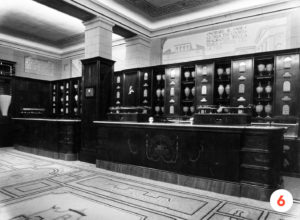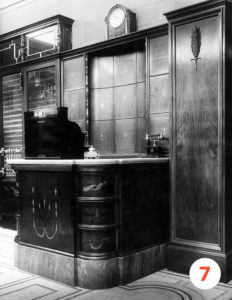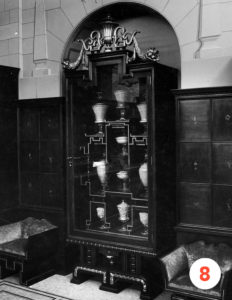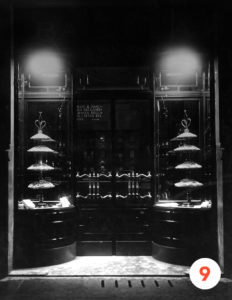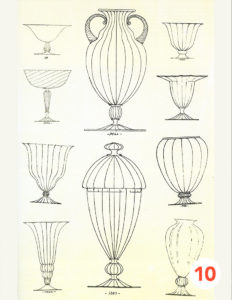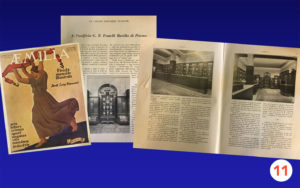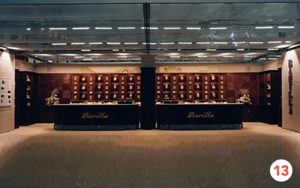The Murano vases of the Barilla shops (1929)
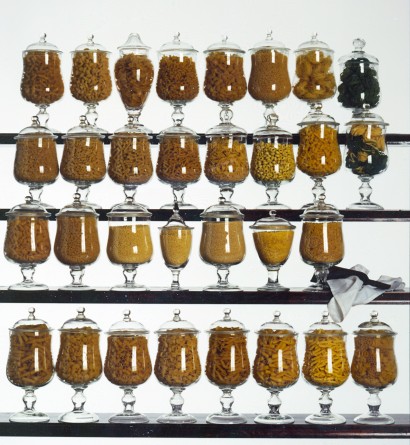
by Giancarlo Gonizzi
– “Have you ever been to the air-raid shelter?” It was Mrs. Natalia, who arrived on a May morning at the archives, to ask me that question. A true company “institution”, Natalia had entered into the service of Mrs. Virginia Barilla (1890-1976) when just a bit more than a child and now, several decades after, she was at the guidance of the society that managed the cleaning services in the various headquarters of the Barilla Group,
I knew of the existence of an air-raid shelter dug underground in the courtyard of the Company a few months after the break of World War II, because I saw the little entryway in some period photographs kept at the archives (photo 1). But nothing more than that. Indeed, I was convinced that the shelter had disappeared with the remodeling of the plant made in the 1960s.
– Does it still exist? – “Sure! If you wish, I will take you there”
We walked across the courtyard and entered the building that once was the Barilla Family home (photo 2). Designed by Stuttgart architect Karl Elsasser in 1933, it was an out of the ordinary example of Déco architecture, with precious polychrome marble used as wall coverings for the monumental staircase and Cipollino marble for the columns of the ample open space (photo 3) created to host the administration offices.
But this time, we did not go to the upper floor, where the apartments of the Family were located. Mrs. Natalia opened a small door that lead us to a cellar with cement walls and after crossing a number of corridors, we turned toward the direction of the courtyard without hesitation.
At the end of a short corridor a small underground room with a safety lamp at the center of the ceiling and benches all around opened up. The light did not work and the shadows were brightened only by a dim thread of light coming through a gable. This place had harbored the employees during the frequent air-raid alarms of 1944-45. A few empty dusty boxes testified that the place had been used as a catchall room. It was a memory of the past, but nothing special.
But looking up, I realized that above the benches there was a wooden shelving that went all around the room, and it did not seem empty. Something like dusty ghosts were stuck on top of the white painted shelves. – But what are these? – “They are the vases from the shops. When they were dismissed, at the end of the war, Mrs. Virginia hade them brought here.”
I carefully took one of them and after blowing the dust away, the silhouette of an elegant glass vase emerged from an opaque cloud. The rough cut and the absence of burrs made it clear to me that it was blown glass. There were dozens of them, of various shapes and measures.
– Mrs. Natalia, we shall bring them to the Historical Archives. “All of them’” – Yes, all of them, including the odd lids and the scattered pieces.
The day after, all bright and clean, 31 complete vases (photo 12) and some conch shaped fragments arrived at the Archives. I recuperated the photos of the Barilla shops: in the premises of Strada Vittorio Emanuele (photo 4) – where the company was born in 1877 – 60 vases containing the various formats of unpackaged pasta were displayed in a row. In the amazing boutique opened in 1929 on Strada Cavour – the city promenade – designed by architect Mario Bacciocchi (1902-1974), there were vases on the cupboard, of different shapes, and also some “fountain” stands – that’s where the fragments came from (photos 5-6-7-8-9).
An article published in “Aemilia” in December of 1929 featured a few images of the shop setting and described the remodeling work in detail (photo 11). From those lines, a name emerged. The vases where designed by Bacciocchi himself, and had been made in the glass shops of the Toso Brothers in Murano! That name was too famous to go unnoticed. It was a name that fortunately is still famous today.
A search in the phone book, a phone call, and I was on the line with the owner: yes, they had an archive; yes, it was possible to consult it and there were many people who ask them to; yes, they remembered working for Barilla, and they should still have the drawings…
A few months later, taking advantage of a trip to Venice, the magic of Murano welcomed me with its furnaces and design glass everywhere. However, Barilla was not found in their file cabinet. How strange… We tried looking up the name of the architect and the designs of the vases that I knew and of those that I only saw in photos and that do not exist anymore came up. Today, a copy of the designs (photo 10) is at the Barilla Archives.
A happy ending adventure? Truly, that was only the beginning. The search for the original furnishings did not have positive results: confused witnesses and a war in between made it hard to hope for the best. But the idea to reconstruct that extraordinary shop was born because of this, thanks to the clever hands of Ruggero Monica (1930-2019).
The favorable occasion was the setting up of a stand for Cibus, the International Food Fair of 1998. The patience of architect Gianni Capelli, who studied the history of urban and commercial development of the city, made it possible to design the structure of the furnishings anew, starting from the beautiful photos by Alberto Montacchini (1894-1956) stored at the Archives. Francesca Ghinelli, a promising student of the Institute of Art, traced and faithfully reproduced the architectural details painted by decorator Tito Peretti (1903-1980) in the frieze below the ceiling.
Guido, Luca and Paolo Barilla liked the idea and with the cooperation of architects Alberto Bordi, Sauro Rossi and Marco Zanotti a truly unique stand (photo 13) was set up, featuring the philological reconstruction of the furnishings on three sides and futuristic multimedia screens on the fourth side, to suggest innovation respectful of tradition.
The air-raid shelter does not exist anymore today: the urban transformation of the Barilla area in 1999 and the construction of the Barilla Center and the large underground parking area made it disappear.
But the Murano vases still hold all of their history…
